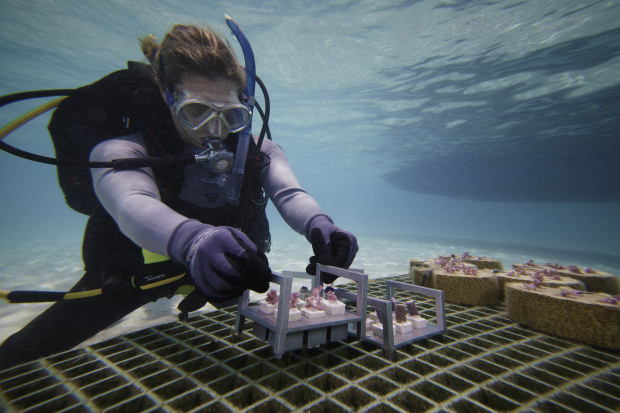“Coral reef restoration has been happening around the world for the last few decades, but it’s mostly been NGOs doing it on a very small scale, and doing everything manually,” Dr Foster told The Australian Financial Review.
“I’ve got a really unique perspective because I’ve seen how you can scale things in the manufacturing industry, and I can see that we’re not using any of those techniques in reef restoration.”
Coral Maker has partnered with a local commercial coral grower Abrolhos Coral and Live Rock, and has begun placing its seedlings and coral skeletons in the ocean at the Abrolhos Islands.

Coral Maker has begun placing its coral seedlings and man-made skeletons off the WA coast. Tim Campbell
Traditionally, propagating new coral involves taking a live cutting from an existing colony, and then manually grafting it and allowing that piece to grow its own skeleton.
Coral Maker aims to scale the restoration process, making it possible to repair reefs that have suffered bleaching events more quickly, and even relocate coral colonies to locations that are better placed to withstand climate change.
The process could shave years off the time it takes for new coral to reach maturity. Dr Foster says that, depending on the species, the coral takes three to 10 years to reach adult size when starting with a small fragment.
By putting a group of the same coral together on a skeleton, she says they will join up and fuse to cover the base structure, which could take 18 months to a few years to reach maturity.
Dr Foster says she was inspired to start the business following major coral bleaching events while she was researching her PhD on how climate change affects coral reefs.
She moved to San Francisco to study at the California Academy of Sciences, to learn how technology such as robotics, 3D design and engineering could be adapted to scale the coral restoration process.
Dr Foster had originally planned to use 3D printers to recreate the “complex, beautiful” shape of coral, but found the machines were too slow to produce enough structures to accelerate the process of reef restoration.
“The more I looked into that, the more I realised that it was going to be very tricky to scale with 3D printing, which takes hours just to print one skeleton,” she said.
That realisation led Dr Foster back to her roots and she began working out how traditional brick-making machines could be adapted to produce thousands of less-complex shapes each day that could house the coral seed plugs.
While studying in the US, Dr Foster joined the Autodesk Technology Centres’ Outsight Network residency, which gave her access to pro bono support from the Autodesk Foundation.
Autodesk makes 3D design, engineering and construction software, and its employees across North America and England assisted Coral Maker in its use and advanced manufacturing and robotic automation.











